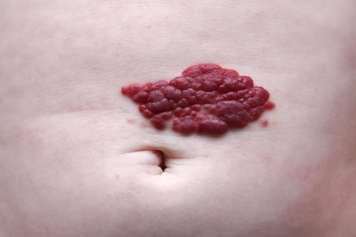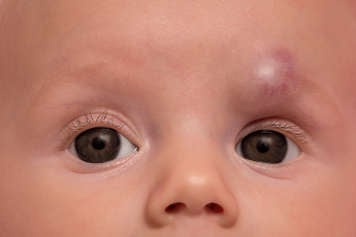Babies can have skin changes at birth or develop many types of skin conditions shortly after they are born. A lot of these conditions last only a short time and will go away. Others, however, are birthmarks that my not be visible at birth but will stay with babies throughout their lives.
Newborn baby skin conditions
Below is a description of the most common skin conditions in newborn babies.
Desquamation
Desquamation (say: des-kwa-may-shun), or skin peeling, is something that affects most babies in the first few days of life, especially if they are born after their due date. It is completely normal and can resolve on its own.
How to treat it: Apply moisturizer to the skin.
Cradle cap
Also known as seborrheic dermatitis, this is a crusty greasy scalp rash that commonly occurs in newborn and slightly older babies. It happens when there is a build-up of sebum (an oily substance produced by glands in the skin) that makes skin cells stick together instead of shedding normally. It can occur on the scalp alone or with a diaper, neck or underarm rash.
How to treat it: Treatment is not always needed. Cradle cap usually clears up on its own within a few weeks to months. In some infants, it can persist for longer. If you would like to treat cradle cap, you can apply mineral oil or petroleum jelly to loosen the crusts. If this is not enough, your doctor can recommend other treatments.
Milia
These are small white bumps on the baby's face. They look like whiteheads, but they are small cysts filled with sebum and keratin (a type of protein that makes up the outer layer of skin as well as a person's hair and nails). Sometimes milia are present in the gums and on the hard palate (known as "Epstein pearls"). They are very common during the first few days of life and go away eventually without any treatment.
How to treat it: No treatment is necessary. Milia goes away on its own.
Miliaria
Miliaria is commonly called "prickly heat" or "heat rash". It has many different appearances: you could find tiny red bumps or little blisters filled with fluid or pus, usually on the baby's chest or back, underarms or neck. It happens when sweat ducts on the skin become blocked. It sometimes appears after intense heat or if the baby is too bundled up.
How to treat it: The rash eventually disappears on its own without any treatment. You can prevent this rash by avoiding dressing your baby in many layers of clothing and trying to avoid hot temperatures.
Neonatal cephalic pustulosis
Previously called "neonatal acne", this is a very common rash in babies. It occurs mostly on the face and scalp and looks like pimples (papules and pustules), but there are no whiteheads, blackheads or deeper nodules. While the cause is not entirely clear, it is thought to possibly be related to yeast that lives on the skin.
How to treat it: Treatment is generally not required as neonatal cephalic pustulosis typically resolves on its own within several weeks or months. When desired, your doctor can prescribe certain creams that may help.
Erythema toxicum neonatorum
Erythema toxicum (say: er-ith-em-a tox-ik-um) occurs in the first three to five days after birth. It is a rash of small red dots (although some can have a central white dot) that usually appears on the chest, back, face and arms. This is a normal reaction in babies' skin, and it goes away within a day to a few weeks.
How to treat it: No treatment is necessary. Erythema toxicum neonatorum goes away on its own.
Transient pustular melanosis
Transient pustular melanosis (say: tran-zee-unt puss-tu-lar mel-an-oh-sis) is a type of rash that is more common in darker-skinned babies. It appears from birth as tiny white raised bumps on a baby's neck, chest, back or buttocks. The bumps last a few days before rupturing and leaving behind a ring of scale. The scale goes away on its own but sometimes leaves behind a darker area of pigmentation, which can last for months before disappearing.
How to treat it: No treatment is necessary. Transient pustular melanosis goes away on its own.
Sucking blisters
Sometimes a blister can be seen at birth on the forearm, wrist, hands or fingers, caused by the infant sucking on that area while in the womb. Your doctor will help to differentiate sucking blisters from rarer, more serious conditions.
How to treat it: No treatment is required. Sucking blisters resolve within a few days.
Birthmarks
Many babies are born with birthmarks, some of which can be worrying for parents. Some birthmarks disappear over time, while others stay with the child for life. Below are descriptions of the most common types of birthmarks.
Infantile hemangiomas


An infantile hemangioma (say: he-MAN-jee-oh-ma) is the most common birthmark made of blood vessels. It happens when groups of blood vessels grow rapidly, much faster than any other part of the baby's body. In the past, it was called "strawberry hemangioma" because it is sometimes bright red and raised and can look like a berry. Some hemangiomas occur deeper in the skin and might look like a skin-coloured or bluish bump underneath the skin's surface.
Infantile hemangiomas are usually not present at birth or may only be a reddish patch on the skin. However, after a couple of weeks, it starts getting bigger and becomes raised. It can continue to grow for several weeks before becoming stable and then shrinking until it disappears. Deeper hemangiomas behave in the same way as those on the skin's surface and also disappear with time.
It is usually not possible to predict how long a hemangioma takes to disappear. The smaller they are, the faster that they disappear, but this could still take many years.
Most hemangiomas do not need treatment, but if they occur on specific areas such as the face (especially around the eyes or lips) or the genital area, they could cause disfigurement or interfere with bodily functions. In these cases, treatment should be considered. Your doctor can tell you what options are available.
Nevus simplex
Nevus simplex (say: nay-vus sim-plex) is a pink or reddish patch of skin most commonly seen between the eyes, on the forehead or on the back of the neck. People commonly call these patches "stork bite" or "angel's kiss". They are caused by dilated blood vessels that give the skin a reddish colour. Most of these patches disappear within several years.
Vascular malformations
Vascular malformations (say: vas-ku-lar mal-form-ay-shuns) are another type of birthmark caused by blood vessels. They can look very different depending on the type of blood vessels involved and where they occur on the body.
The most common malformations are called "port wine stains", so called because they look like dark red areas of skin. When these malformations are large and are near the eyes, the doctor should check the baby to make sure the blood vessels in their brain and inside the eye are healthy. These birthmarks stay with a child for the rest of their life.
Congenital dermal melanocytosis
These are grey or bluish areas of skin that sometimes look like bruises. They are very common in Asian children and most commonly occur on the back or the buttocks, but they can be seen anywhere on the skin. They are caused by pigment cells that are trapped in the deeper layers of the skin and have not reached their typical location in the upper layer of skin, known as the epidermis. Congenital dermal melanocytosis are benign and usually fade by 4 years of age without treatment. However, when these birthmarks are located in areas other than the lower back, they are less likely to fade with time.
Café-au-lait spots
Café-au-lait spots are well-defined, brown, oval, flat spots that are caused by increased local pigment production in the skin. They appear anywhere on the skin from birth or during early childhood. The size can range from as small as a freckle to larger spots. Having one spot is common; however, if there are multiple spots, this should be checked by a doctor. These birthmarks stay with a child for the rest of their life.
Melanocytic nevi
Melanocytic nevi (say: mel-an-oh-sigh-tik nay-vee) are more commonly known as moles. They are made of the cells that produce the pigment, or colour, of the skin and are light or dark brown. A lot of babies have moles present from birth, or moles can appear in the first few months of life or later. However, some babies have large or many moles all over their body and will need to be examined by a doctor. Moles do not disappear with time.
Looking after your child's skin and nails
Skin care
A baby's skin is much thinner and more fragile than an adult's, so you should care for it differently.
- Bathe your child gently with a mild soap in warm water for five minutes. You can use the same soap to clean their scalp.
- After bathing, apply a gentle moisturizer all over the skin and a protective cream on the diaper area to prevent diaper rash.
There are no preferred brands for cleaning or moisturizing your child's skin. The most important thing is that the products you use are mild and as fragrance-free as possible.
Nail care
Babies play with their hands and can scratch themselves with their nails, even if they are extremely thin and tiny.
- Keep your baby's nails short and clean.
- You can cut them with blunt scissors or with a baby nail clipper, making sure you avoid the skin on the finger pads.
- As babies' nails grow faster than adult nails, you will need to trim them every one or two weeks.
